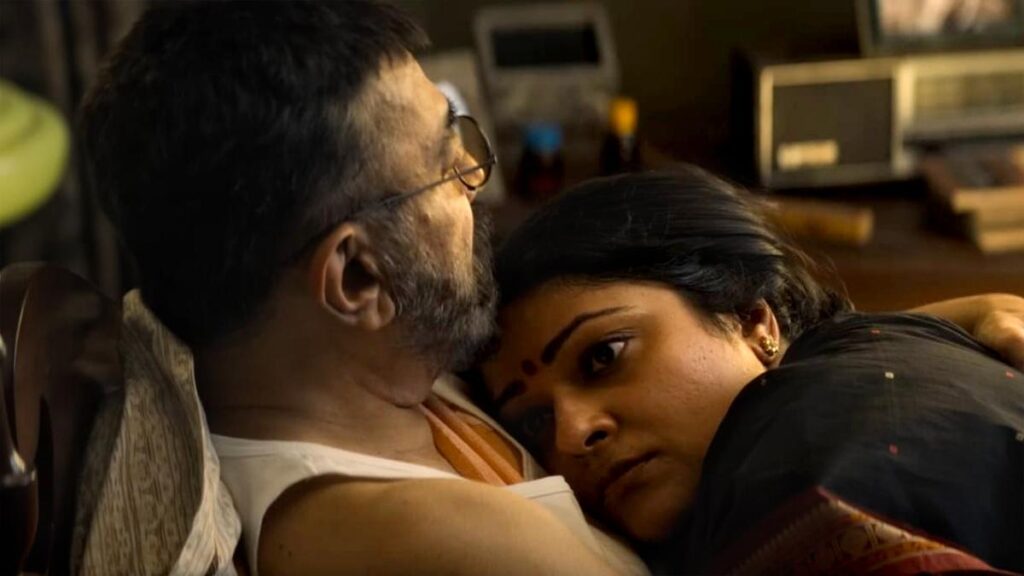South Indian filmmakers have kept their focus on the single-screen cinemagoer.
They have kept their finger on the pulse of the single-screen cinema fan, who goes to movies once a month or more, to forget his weekly chores, explains Ambi Parameswaran.

IMAGE: Kamal Haasan and Abhirami Gopikumar in Thug Life.
‘South emerges the new hero in India’s cinema landscape‘ read the headline of an article that traced the box office collection trends of movies post-Covid].
The article also presented some interesting figures about the number of movie screens (cinemas) in India.
A question arises: How important is moviegoing in the life of an average Indian?
When I started my life in advertising in 1979, I was a client servicing executive who was also tasked with the job of media planning.
Those were the days of calculators and the large bound editions of the National Readership Surveys.
What fascinated me was the stark difference between moviegoing habits of South Indian and North Indian consumers.
Almost 50 per cent of urban adults in South India visited cinema halls every month.
The number for North India was less than 15 per cent.
Those were the days of single-screen cinemas, and cinema advertising was a monopoly of a company called Blaze Advertising.
Again, going over the list of movie halls provided by Blaze, one could see that South India had a lot more and better quality cinemas than North India.
A trivia: Probably the first multi-screen cinema complex was in what was then called Mount Road in Madras (now Chennai).
Called the Safire complex, it had four screens; now, no more.
Coming to the disparity in viewing habits, was it just supply creating its own demand?
More cinema halls, so more people visiting cinemas? Or was something more at work?
The question of disparity in the number of cinema halls between North and South India was brought out by the abovementioned article, too.
For instance, Uttar Pradesh has only 601 cinema screens (EY-Ficci Report, 2025), while Tamil Nadu has 1,158 and Andhra Pradesh plus Telangana have 1,771 screens.
The multiplex revolution has had no impact on the difference between South and North Indian screen population.
Of the total screens in India (9,927), multiplexes account for only 40 per cent, though their share of collection is higher.
Single screens still command a significant presence in South India, and that may be a reason for the resilience of the southern cinema business.
When Covid hit, there was widespread gloom in the cinema industry. OTTs were having a merry time.
Why will a consumer go to a cinema and watch a movie when he can see it all, without any trouble at home?
The recovery of the medium was expected to take a long time.
Incidentally, the global movie industry is yet to hit the pre-Covid collection numbers.
But cinemas in South India bounced back rather quickly, even delivering national hits one after the other.
Hindi movies, which accounted for 45 per cent of national box office in 2018, have dropped to 40 per cent in 2024; even Malayalam movies have moved from 5 per cent to 10 per cent in the same period.
Two questions remain. What did southern filmmakers do that Hindi filmmakers missed out on?
And what is the reason behind this huge difference in the South versus North per capita screen availability?
Experts have said that South Indian filmmakers have kept their focus on the single-screen cinemagoer.
They have kept their finger on the pulse of the single-screen cinema fan, who goes to movies once a month or more, to forget his weekly chores.
And cinema fans have repaid them with their wallets. Northern moviemakers have got carried away with the multiplex glamour and did not tailor their fare.
The multiplex audience was now juggling between the sea of choices on OTT channels versus the cinema screen.
It should, however, be admitted that Hindi did have a revival moment in 2023 with some mega hits like Jawan and Pathan.
Will Hindi moviemakers find their magic touch again in 2025? They had not found their rhythm at least till April 2025.
Coming to the second question: Why is there this huge difference in the per capita availability of screens?
Legend has it that the Madras Presidency had a governor who encouraged the building of cinema halls as a way of improving government propaganda.
This led to a spurt in the number of cinema halls in the old Madras Presidency. One thing led to another.
More cinemas led to increased cinemagoing. This probably led to more cinema halls being built.
A positive cycle started spinning — and has continued to spin.
I suppose the growth of cinema halls in the Madras Presidency had its own ripple effect in the neighbouring regions of Malabar and Mysore.
Post-Independence, both in Tamil Nadu and the erstwhile Andhra Pradesh, the political parties were cinema friendly, and that helped.
The North did not have such a positive cycle. And even with the advent of multiplexes, the gap between South and North has not diminished.
All is not lost. China had fewer cinema screens than India till 20 years ago. In a shocking burst of scale, China moved from just 4,400 screens in 2005 to 90,000-plus by 2024.
Will we see this happen in India? Is there a need to create more economical multiplex experiences? Is there a need to create innovative ticketing options?
Many questions remain. Till those are answered, let us enjoy the movies, masti, magic of south Indian cinema.
Ambi Parameswaran is a bestselling author, an independent brand coach, and founder of Brand-Building.com
Feature Presentation: Aslam Hunani/Rediff

